1970 in the Vietnam War
| 1970 in the Vietnam War | |||
|---|---|---|---|
Blueboy assault group aboard Banana HH-3E at the start of Operation Ivory Coast | |||
| |||
| Belligerents | |||
|
Anti-Communist forces: |
Communist forces: | ||
| Strength | |||
|
South Vietnam: 968,000 | |||
| Casualties and losses | |||
|
US: 6,081 killed[1] South Vietnam: 23,346 killed [2]:275 | Unknown | ||
January
- 6 January
Under the cover of monsoon rains the Vietcong (VC) 409th Battalion attacked the 1st Battalion, 7th Marines at Firebase Ross with mortars and sappers penetrating the wire. The attack was repulsed by 04:00 with 13 Marines and 38 VC killed.[3]:48–50
- 19 January to 22 July
The 1st Brigade, 5th Infantry Division launched Operation Green River in Quảng Trị Province. The operation results in 106 People's Army of Vietnam (PAVN) soldiers killed and 37 U.S. killed.[4]
- 21 January
A PAVN/VC artillery attack on Bien Hoa Air Base damaged a C–123, a C–7 and a UH–1.[5]:246
February
- 19 February
In the Son Thang massacre five U.S. Marines killed five Vietnamese women and 11 children in Sơn Thắng, Quế Sơn District. Four of the Marines were charged with murder, two were acquitted and two convicted but only served sentences of one year.[3]:345–7
- 27 February
A PAVN/VC rocket attack on Bien Hoa Air Base damaged three A-37s, two F-100s and a C-7. Two USAF personnel were killed in these attacks and 74 wounded.[5]:246
March
- 12 March
On 12 March, Cambodian prime minister Lon Nol closed the port of Sihanoukville to the North Vietnamese and demanded that all PAVN and VC forces withdraw from Cambodian soil within 72 hours (on 15 March) or face military action.
- 14 March - 12 April
In the SS Columbia Eagle incident two crewmembers seized the SS Columbia Eagle with the threat of a bomb and handgun and forced the captain to sail towards Cambodia. Twenty-four of the crew were forced to abandon the ship in lifeboats, while the remaining 13 sailed the ship into Cambodian waters and the two mutineers Clyde McKay, Jr. and Alvin Glatkowski surrendered to the Cambodia government which gave them asylum. The mutineers were later arrested and imprisoned in Cambodia, but released later in the year. Glatowski eventually turned himself in to the U.S. Embassy, was extradited to the U.S. and served seven years in prison, while McKay sought refuge with the Khmer Rouge who apparently killed him.[6]:141
- 16 March
A U.S. Navy EC-121 Warning Star crashed on landing at Da Nang Air Base. The aircraft struck a hangar and caught fire killing 22 of the 31-man crew.[7]
- 18 March
The Cambodian National Assembly voted to remove head of state Prince Norodom Sihanouk from power with Lon Nol taking the powers of the Head of State on an emergency basis.
- 20 March
The PAVN attacked Firebase Granite, the attack was repulsed with 10 U.S. and 10 PAVN killed.[8]
- 23 March
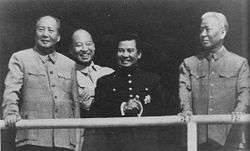
Norodom Sihanouk on Beijing radio called for a general uprising against Lon Nol.
- 26 March
North Vietnam refused an offer by South Vietnam for the release and repatriation of 343 wounded or ill prisoners of war, declaring that there were no members of the PAVN in the south. The North Vietnamese representatives at the Paris Peace Talks asserted that the captives were, instead, "illegally arrested patriots" from among South Vietnamese citizens rebelling against the Saigon government.[9]
- 29 March
The PAVN 272nd Regiment hit Firebase Jay with mortar, rocket and recoilless rifle fire hitting the command post and knocking out communications. The base was occupied by Companies A and E, 2nd Battalion, 7th Cavalry, B Battery, 2nd Battalion, 12th Artillery and B Battery, 2nd Battalion, 19th Artillery. The PAVN then launched infantry attacks on the base perimeter but were beaten back by dawn. U.S. losses were 13 killed, while 74 PAVN dead were found in and around the base.[10]:617–8
April
- 1 April
199th Infantry Brigade commander Brigadier General William R. Bond is killed by sniper fire in Bình Thủy District.[11]:12
The PAVN hit Firebase Illingworth with over 300 rounds of mortar and recoilless rifle fire and then assaulted the base with a force of over 400 troops. The base was defended by Companies C and E, 2nd Battalion, 8th Cavalry, B Battery, 5th Battalion, 2nd Artillery, A Battery, 1st Battalion, 30th Artillery, A Battery, 2nd Battalion, 32nd Artillery and B Battery, 1st Battalion, 77th Artillery. During the attack an ammunition dump containing over 190 rounds exploded. By 05:00 the attack had been repulsed at a cost of 24 U.S. killed and 54 wounded and 88 PAVN killed.[12]
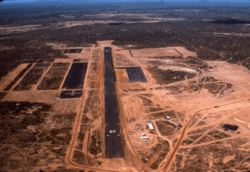
Three PAVN battalions attacked Song Mao Base Camp which was defended by the U.S. 2nd Squadron, 1st Cavalry and the ARVN 44th Regiment, 23rd Division. The attack was repulsed resulting in 2 U.S., 2 ARVN and 151 PAVN killed.
- 1 April to 8 May
The PAVN besiege Dak Seang Camp. On 15 April 1970 the 170th Assault Helicopter Company dropped the 3rd Battalion, 42nd ARVN Regiment into a landing zone near Dak Seang, resulting in the loss of two helicopters.
- 1 April to 5 September
Operation Texas Star was a military operation of the U.S. 101st Airborne Division and the Army of the Republic of Vietnam (ARVN) 1st Division against PAVN logistics routes and bases in the A Shau Valley and the mountains east of the valley. The operation culminated in the Battle of Fire Support Base Ripcord.[13] The operation resulted in 1,782 PAVN killed and 5 captured, U.S. losses were 386 killed and ARVN losses were 370 killed.[14]
- 4 April
A group of 50,000 demonstrators picketed in Washington D.C. in the "March for Victory", organized by fundamentalist radio evangelist Carl McIntire. The marchers, mostly middle-aged white Americans, protested President Nixon's decision to reduce the American commitment rather than to take the war into North Vietnam.[15]
- 5 April
Photojournalist Gilles Caron disappeared on Highway 1 in Cambodia. He was the first of 25 journalists to disappear or be killed by the Khmer Rouge/PAVN between 5 April and 28 October 1970.[16]
- 6 April
Photojournalists Sean Flynn and Dana Stone disappeared on Highway 1 in Cambodia. Later investigations revealed that they were captured by the PAVN and then handed over to the Khmer Rouge who executed them.[17]
- 10 April

Following a mortar and Rocket-propelled grenade barrage, PAVN sappers attacked Mai Loc Camp which was defended by CIDG forces and a U.S. artillery unit. The PAVN withdrew leaving 19 dead, while U.S. losses were six killed and 14 CIDG were killed.[18]
- 12 April - May
Two PAVN battalions attacked Dak Pek Camp and the defenders were forced back to a small fighting position before air support forced the PAVN back. The PAVN then besieged the camp until early May when they withdrew. Total losses were 34 CIDG and 420 PAVN killed.[19]
- 13 April
In the village of Xom Bien, a massacre of about 600 Vietnamese Cambodians was carried out by the Khmer National Army (ANK) as part of a campaign by the Lon Nol government against the nation's Vietnamese-speaking minority. Shortly after midnight, troops entered the village, founded as a Roman Catholic mission on the waters of the Mekong River in the Chrouy Changvar area near Phnom Penh and removed the men and boys and shot them. Days later, hundreds of the corpses of the victims (which included more from outside of Xom Bien) were seen floating down the Mekong into South Vietnam.[20]
A PAVN sapper company attacked Firebase Nancy defended by a unit of the ARVN 1st Regiment, 1st Division and a U.S. artillery unit, returned fire and the PAVN withdrew. At dusk ARVN soldiers sweeping the perimeter made sporadic contact with PAVN. PAVN losses were 71 killed and nine captured and 11 individual and six crew-served weapons captured; U.S. losses were four killed.[11]:37
- 16 April
The PAVN 95C Regiment attacked Firebase Atkinson which was defended by Companies B and E, 2nd Battalion, 7th Cavalry and B Battery, 2nd Battalion, 19th Artillery. The PAVN attacks were beaten back with seven U.S. and 66 PAVN killed.[10]:723
- 20 April
President Nixon announced that he would order the withdrawal of a further 150,000 American troops from South Vietnam over the next 12 months as part of the process of turning conduct of the war over to the South Vietnamese.[21]
- 22 April
In a meeting at the White House of his National Security Council, President Nixon discussed the options for the U.S. response to the continuing use of Cambodia by the PAVN/VC as a base. National security adviser, Henry Kissinger, would recount later that the three choices were to continue the current response, favored by Secretary of Defense Melvin Laird and Secretary of State William P. Rogers; providing financial and adviser aid to an invasion by the ARVN without committing ground troops (favored by Kissinger); or sending U.S. troops and planes into Cambodia to attack the sanctuaries (favored by General Earle Wheeler, the Chairman of the Joint Chiefs of Staff). While Nixon supported Kissinger's option, U.S. Vice President Spiro T. Agnew made the argument for committing U.S. troops to Cambodia, the decision that Nixon ultimately adopted[22]
- 23 April
President Nixon issued an Executive Order ending any future deferment from the military draft based on occupation, agriculture or fatherhood.[23]
- 29 April
The PAVN again attack Firebase Granite, the attack is repulsed with seven U.S. killed and one missing and 18 PAVN killed.[24]
- 29 April – 22 July
The Cambodian Campaign (also known as the Cambodian Incursion) was a series of military operations conducted in eastern Cambodia by the U.S. and the South Vietnam. A total of 13 major operations were conducted by the ARVN and U.S. forces between 1 May and 30 June.[13] In addition to the capture of large amounts of supplies and equipment 11,369 PAVN/VC were killed and 2,328 captured, ARVN losses were 638 killed and 35 missing and U.S. losses were 338 killed and 13 missing.[25]
- 30 April
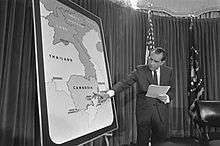
In a nationally televised address, President Nixon announced that he had sent 2,000 American combat troops into Cambodia and ordered U.S. B-52 bombers to begin airstrikes. Nixon reversed his April 20 announcement that he would withdraw 150,000 troops from Vietnam over the next year, in effect providing that there would again be a need to draft young American men to maintain the current force level. Nixon told viewers "This is not an invasion of Cambodia." rather the attacks were upon territory in Cambodia that were "completely occupied and controlled by North Vietnamese forces."[26]
May
- 1 May
Operation Toan Thang IV a multi-division U.S./ARVN operation in III Corps concludes. U.S. losses are 685 killed while PAVN/VC losses are 14,479 killed.[11]:83
Protests against the expansion of the war into Cambodia began on U.S. college campuses.[27]
For the first time in more than 50 years, the U.S. Senate Foreign Relations Committee voted to ask for a meeting with a U.S. president, after having been given no notice of the invasion, and the request was unanimous from both political parties.[28]
- 4 May
Four college students were shot and killed at Ohio's Kent State University, and nine others wounded by Ohio National Guardsmen, during a protest against the incursion into Cambodia.[29]
- 5 May
Prince Sihanouk announced from Beijing that he had formed a government-in-exile that would ally with the Communist government of China and the Khmer Rouge to overthrow head of state Lon Nol. Sihanouk's group was called "GRUNK" and was a coalition of government officials exiled in China (former premier Penn Nouth as the Prime Minister) and Khmer Rouge leaders within Cambodia, chief of whom was Khmer Rouge leader Khieu Samphan).[30]
- 6 May
At 05:00 the PAVN 33rd Sapper Battalion attacked Firebase Henderson south of Ca Lu, Quảng Trị Province, which was occupied by elements of the 2nd Battalion, 501st Infantry Regiment, 2nd Battalion, 11th Artillery, 326th Engineer Battalion and ARVN units. The attack resulted in 27 U.S., 3 ARVN and 29 PAVN killed.[31][32]
The PAVN/VC attacked Quế Sơn District Headquarters with mortar fire followed by a battalion-sized ground attack. Marines of Company H, 2nd Battalion, 5th Marines, supported by artillery aided the besieged RF/PF units. The RF/PF lost 10 killed, the Marines one killed and the PAVN/VC 27 killed.[3]:444
- 7 May
The PAVN attacked Firebase Maureen which was defended by a platoon of the 1st Battalion, 506th Infantry.
- 8 May
A group of 500 construction workers attacked a group of 1,000 student antiwar protesters outside of New York City Hall, near the intersection of Wall Street and Broad Street. More than 60 people were injured.[33]
- 9 May
Hours before a large anti-war protest began at Washington, D.C., President Nixon surprised most of his Secret Service bodyguards and about eight demonstrators by walking in to the Lincoln Memorial at 4:55 in the morning. The Associated Press described it as a "strange encounter, unique in recent political annals."[34] As word got around that the President was chatting with students, the group had increased to 50 by the time he left, and his parting words were "Go shout your slogans on the Ellipse. Just keep it peaceful."[35] Later in the day, a crowd of about 100,000 demonstrated peacefully in the event organized by the New Mobilization Committee to End the War in Vietnam in one of many anti-war protests that took place across the nation that day.[36]
- 12 May
Major General John A. B. Dillard and eight others were killed when their helicopter was shot down southwest of Pleiku.[37]
- 19 May
A PAVN rocket attack on Pleiku Air Base destroyed an EC-47 and damaged two more.[5]:246
- 20 May
A pro-war rally attracted 150,000 people to New York's City Hall Park, with a crowd that included blue collar workers and union members who supported the Nixon administration's policies in the war.[38]
Chinese Communist Party Chairman Mao Zedong, the de facto leader of the People's Republic of China, issued a statement to his people for the first time in five years, with Radio Peking delivering the word to listeners nationwide. Urging Chinese citizens to work together "to defeat U.S. imperialism" in Vietnam and Cambodia, Mao's statement declared, "People of the world, unite and defeat the U.S. aggressors and all their running dogs!" Mao went on to say that "Nixon's fascist atrocities have kindled the raging flames of the revolutionary mass movement" and added that "The Chinese people firmly support the revolutionary struggle of the American people", predicting that "the fascist rule in the United States will inevitably be defeated."[39]
- 28 May
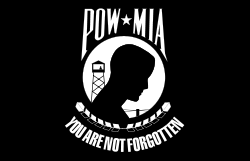
The National League of POW/MIA Families was incorporated by a group of wives of American servicemen who were listed as prisoners of war or missing in action in the war.[40]
June
- 3 June
President Nixon announced in a nationwide television and radio address that American troops would be pulled back out of Cambodia after the achievement of "all our major military objectives", and that half of the 31,000 U.S. troops in Cambodia had been returned to fight in South Vietnam.[41]
- 11 June
The VC kill 78 South Vietnamese civilians in Thanh My hamlet, Phu Thanh village, Quảng Nam Province in the Thanh My massacre.[3]:177–8
.jpg)
- 12-16 June
In the Battle of Kompong Speu a combined forces of the ARVN and ANK fought to recapture the provincial capital of Kompong Speu. The town was captured by PAVN/VC forces on June 13 but was retaken by allied forces on June 16.
- 15 June
The Battle of Prey Veng was part of the ARVN's campaign in Cambodia. It took place in Prey Veng on June 15, 1970, where ARVN and Cambodian troops battled the PAVN/VC. It ended with an allied victory.
- 22 June
Đặng Thùy Trâm a 27 year old PAVN doctor and a colleague were killed near Đức Phổ, Quảng Ngãi Province by a patrol from the U.S. 4th Battalion, 21st Infantry Regiment in a Free-fire zone. Two of her diaries recovered by U.S. forces were later published under the title Nhật ký Đặng Thùy Trâm (Đặng Thùy Trâm's Diary (Last Night I Dreamed Of Peace)).[42]
- 24 June
The United States Senate voted to repeal the Gulf of Tonkin Resolution that had supported U.S. intervention in the Vietnam War since 1964.[43]
- 29 June
The last U.S. ground troops withdrew from Cambodia.[44]
- 29 June to 1 March 1971
The 198th Light Infantry Brigade launched Operation Pennsylvania Square in Quảng Tín Province. The operation resulted in 264 PAVN/VC killed and 13 captured, U.S. losses were 20 killed.[45]
July
In response to North Vietnam's support of Soviet Union in the Sino-Soviet split China removes its final anti-aircraft troops from North Vietnam.</ref> [46]
- 1 July
President Richard Nixon named diplomat David K.E. Bruce to head the U.S. delegation to the peace talks in Paris with North Vietnam and the VC.[47]
- 1-23 July
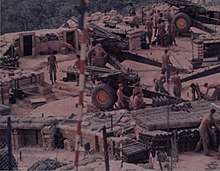
The Battle of Fire Support Base Ripcord was a 23-day battle between the 2nd Battalion, 506th Infantry Regiment, 101st Airborne Division and the PAVN 324B Division from 1 to 23 July. The battle resulted in 422 PAVN and 75 U.S. killed.
- 2 July
To unify command and strengthen the administration of the South Vietnamese military President Thiệu incorporated the Regional and Popular Forces into the ARVN and redesignated Corps Tactical Zones as Military Regions (MRs). Under the reorganization the Corps deputy commander conducted major offensive operations in the MR while the MR deputy commander, in charge of territorial defense and pacification, commanded the RFs and PFs. Concurrently, MACV and the Joint General Staff completed plans to incorporate the CIDGs into ARVN Border Defense Ranger Battalions.[3]:445
- 2-17 July
Operation Maeng Da was a Royal Lao Army (RLA) operation against the PAVN logistics hub at Tchepone. The PAVN 9th Regiment offered stiff resistance and the RLA were forced to withdraw having only temporarily interrupted PAVN supply routes.[48]:269–71
- 3 July
The Hải Lăng PF Platoon; RF group 1/11 and Companies 121 and 122; and CAPs 4-3-2 and 4-1-2, located nine kilometers southeast of Quảng Trị, were attacked by a PAVN/VC force. Supported by gunships and artillery, the Marines/ARVN killed 135 PAVN/VC and captured 74 weapons while losing 16 killed and six missing.[3]:445
- 7 July
1st Cavalry Division commander Major General George W. Casey and six others were killed when their helicopter crashed into a mountain in poor weather.[49]
- 9-15 July
The 1st Brigade, 101st Airborne Division and the ARVN 3rd Regiment, 1st Division launched Operation Clinch Valley to engage the PAVN 9th Regiment on the Khe Sanh plateau. The operation resulted in 266 PAVN killed.[50]
- 12 July - 29 September
The 196th Infantry Brigade launched Operation Elk Canyon near Khâm Đức, Quảng Tín Province. The operation resulted in 107 PAVN killed and one captured, U.S. losses were 37 killed.[51]
- 16 July - 24 August

The 1st Marine Division launched Operation Pickens Forest to attack PAVN base areas in the mountains of Quảng Nam Province. The operation resulted in 99 PAVN killed, Marine losses were four killed.[3]:77
- 22 July - 30 January 1971
The 1st Battalion, 11th Infantry Regiment and elements of the ARVN 1st Division launched Operation Wolfe Mountain to conduct reconnaissance in force, rocket suppression and night ambush operations in Quảng Trị Province. The operation resulted in 242 PAVN killed, U.S. losses were 27 killed.[50]:E-13
- 24 July - 11 August
The 1st Brigade, 101st Airborne Division and the ARVN 1st Division launched Operation Chicago Peak in the A Shau Valley. The operation resulted in 99 PAVN killed and 3 ARVN killed.[50]:E-13
August
- August 1970-February 1971
Operation Chenla I was an operation involving the ANK launched the operation during late August 1970 with limited air support from the ARVN and Republic of Vietnam Air Force. The operation was terminated in February 1971, after the Cambodian High Command made a decision to withdraw some units from Tang Kauk to protect Phnom Penh after Pochentong Airbase was attacked. The objective of the operation was to reconnect Skoun and Kompong Cham along Route 7, which was repeatedly attacked by PAVN/VC forces.
- 9 August - 7 October
In the siege of Firebase O'Reilly 570 PAVN were killed for the loss of 61 ARVN and two U.S.[50]:G-9
- 29 August
The Chicano Moratorium against the war began in East Los Angeles. A parade through the streets quickly became violent and three days of rioting followed, spreading into South Los Angeles and into Wilmington, California.[52]
- 30 August
The South Vietnamese Senate election was held and two-thirds of the eligible voters participated despite random attacks on polling places by the PAVN/VC. The polling was for 30 of the 60 seats in the Senate. At least 11 voters were killed, most of them in the Bình Định Province.[53]
A PAVN/VC rocket attack on Cam Ranh Base destroyed two 420,000 gallon jet fuel storage tanks.[54]
- 31 August - 25 September
Operation Honorable Dragon was an offensive by six RLA battalions to capture Pakse Site 26 and disrupt the Ho Chi Minh Trail.[48]:276–8
September
- 1 September
The U.S. Senate voted not to approve a resolution by Senators George S. McGovern (D-South Dakota) and Mark O. Hatfield (R-Oregon) to force President Nixon to withdraw all American troops from Indochina by 31 December 1971. The vote had 39 supporters (including seven Republicans) and 55 voting against it.[55]
- 1 September - 7 May 1971

Operation Imperial Lake, a United States Marine Corps, Republic of Korea Marine Corps and U.S. Army operation in the Quế Sơn District, Quảng Nam Province begins. It was the last operation of the U.S. 1st Marine Division during the war. The operation resulted in 296 PAVN killed and 24 U.S. killed.[3]:89
- 5 September - 8 October 1971
Operation Jefferson Glenn, an operation by the 101st Airborne Division and the ARVN 1st Division to shield critical installations in Huế and Da Nang begins. It was the last operation of the 101st Airborne during the war.[56]
- 9 September
An ANK amphibious force of 1,500 men broke the siege of Kompong Thom after three months, driving away the PAVN and Khmer Rouge forces.[57]
- 11–13 September
Operation Tailwind was a covert incursion into southeastern Laos by a company-sized element of U.S. Army Special Forces and Montagnard commando (Hatchet Force) of the Military Assistance Command, Vietnam Studies and Observations Group (MACV-SOG or SOG). The purpose of the operation was to create a diversion for an RLA offensive and to exert pressure on PAVN forces. The operation resulted in 54 PAVN and three U.S. killed.[48]:276–80
- 26 September - 7 January 1971
Operation Counterpunch was an RLA offensive to recapture Moung Soui and pre-empt the PAVN wet season offensive. The operation succeeded in capturing Moung Soui and delayed the PAVN offensive by one month.[48]:265–7
October
- 7 October
In a nationwide address, President Nixon announced a five-point proposal for a truce to halt the war, with all sides to begin a ceasefire and the release of all prisoners of war, in exchange for broader negotiations in the Paris Peace Talks [58] The North Vietnamese and VC delegations to the Paris Peace Talks both denounced Nixon's proposal the next day as "a maneuver to deceive world opinion," but stopped short of rejecting it entirely.[59]
- 9 October
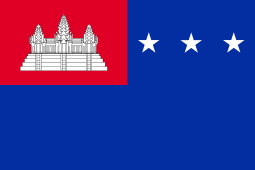
The Khmer Republic was proclaimed in Cambodia, four days after the parliament voted unanimously to abolish the 1,168 year old monarchy. Lon Nol was inaugurated as the republic's first president.[60]
- 19 October - 13 November
The Tchepone Operation was mounted by the RLA to attack PAVN positions at Tchepone and Muang Phine. The operation failed to secure either objective.[48]:268–72
- 28 October
UPI journalists Frank Frosch and Kyōichi Sawada were killed by Khmer Rouge on their way to the Kirirom Pass in Cambodia.[61]
- 30 October
The PAVN attacked Landing Zone Oasis occupied by the 6th Battalion, 14th Artillery and elements of B Battery, 4th Battalion, 60th Artillery resulting in three U.S. killed.[62]
November
- 10 November
CBS broadcast a report showing troops of the 1st Cavalry Division at a firebase smoking marijuana through a shotgun barrel.[6]:104
- 21 November
Operation Ivory Coast was a failed mission to rescue U.S. prisoners of war from the Son Tay prison camp conducted by United States Special Operations Forces and other elements of the U.S. military.
December
- 22 December
North Vietnam released their first accounting of American prisoners of war held there, with a partial list of 368 names in "the closest thing yet to an official accounting by Hanoi".[63]
Year in numbers
| Armed Force | Strength[64] | KIA | Reference | Military costs - 1968 | Military costs in 2020 US$ | Reference | |
|---|---|---|---|---|---|---|---|
| 968,000 | 23,346 | ||||||
| 335,800 | 6,081 | [1] | |||||
| 48,537 | [65] | ||||||
| 11,586 | |||||||
| 6,763 | |||||||
| 74 | |||||||
| 441 | |||||||
References
- "Statistical information about casualties of the Vietnam War". National Archives and Records Administration. United States Government. Archived from the original on 26 January 2010. Retrieved March 6, 2010.
- Clarke, Jeffrey (1988). United States Army in Vietnam: Advice and Support: The Final Years, 1965-1973. Center of Military History, United States Army. ISBN 978-1518612619.

- Cosmas, Graham (1986). US Marines in Vietnam Vietnamization and Redeployment. History and Museums Division Headquarters United States Marine Corps. ISBN 9781494287498.

- "Operational Report - Lessons Learned Headquarters, 1st Infantry Brigade, 5th Infantry Division, Period Ending 31 July 1970" (PDF). Department of the Army Headquarters, 1st Infantry Brigade, 5th Infantry Division. 25 January 1971. p. 3. Retrieved 25 June 2020.

- Nalty, Bernard (2000). The United States Air Force in Southeast Asia: The War in South Vietnam Air War over South Vietnam 1968–1975 (PDF). Air Force History and Museums Program. ISBN 9781478118640.

- Lipsman, Samuel; Doyle, Edward (1984). Fighting for Time (The Vietnam Experience). Boston Publishing Company. ISBN 9780939526079.
- "Headquarters MACV Monthly Summary March 1970" (PDF). Headquarters United States Military Assistance Command, Vietnam. 11 July 1970. pp. 34–5. Retrieved 14 July 2020.

- "North Vietnamese sappers attack jungle firebase". Observer-Reporter. 20 March 1970. Retrieved 14 July 2020.
- "Reds Won't Take Own Sick POWs". Pittsburgh Post-Gazette. 27 March 1970. p. 6.
- Laurence, John (2001). The Cat from Hue. Public Affairs. ISBN 1586481606.
- "Headquarters MACV Monthly Summary April 1970" (PDF). Headquarters United States Military Assistance Command, Vietnam. 17 August 1970. Retrieved 4 July 2020.

- "Battle survivors reunite 40 years later at Fort Sill monument". US Army. 1 April 2010. Retrieved 14 July 2020.
- Stanton, Shelby L. (2003). Vietnam order of battle (2003 ed.). Stackpole Books. p. 13. ISBN 0-811700712.
- Olson, James S. (2008). In Country: The Illustrated Encyclopedia of the Vietnam War. Metro Books. ISBN 9781435111844.
- "'Win In Viet' March Attracts 50,000". Pittsburgh Press. 5 April 1970. p. 2.
- Volkert, Kurt (2001). A Cambodian Odyssey: and The Deaths of 25 Journalists. iUniverse. p. 187. ISBN 9780595166060.
- "How Errol Flynn's son was lost in Cambodia – all but a pile of bones". independent.co.uk. 31 March 2010. Retrieved 9 July 2020.
- "Viet Reds overrun U.S. camp". Chicago Tribune. 10 April 1970.
- "Attack on Dak Pek information for A-242 SF DET". Vietnam Helicopter Pilots' Association. Retrieved 14 July 2020.
- "1,000 Civilians Slain In Cambodia— Youth Describes Massacre Of 600 Seized At Village". Indianapolis Star. 19 April 1970. p. 1.
- "Nixon to Pull Out 150,000 by May '71". Bridgeport (CT) Telegram. 21 April 1970. p. 1.
- "Foreign Relations of the United States, 1969–1976, Volume VI,Vietnam, January 1969–July 1970 Editorial Note". United States State Department Office of the Historian. Retrieved 6 July 2020.
- "Nixon Abolishes Job, Fatherhood Draft Deferment". Pittsburgh Post-Gazette. 24 April 1970. p. 1.
- Nolan, Keith (2007). Ripcord: Screaming Eagles Under Siege, Vietnam 1970. Random House. p. 105. ISBN 9780307416551.
- Tran, Dinh Tho (1979). The Cambodian Incursion (PDF). United States Army Center of Military History. pp. 193–4. ISBN 9781981025251.

- "GIs Attacking in Cambodia, Not an Invasion, Says Nixon". Pittsburgh Post-Gazette. 1 May 1970. p. 1.
- "Tear Gas Scatters Stanford Protesters". Tucson (AZ) Citizen. 1 May 1970. p. 1.
- "Senators call Nixon— Fulbright group wants conference on Cambodia". The Tampa Times. 1 May 1970. p. 1.
- "4 Killed, 10 Hurt At Kent State — Firing Erupts As Guardsmen Chase Crowd". Pittsburgh Post-Gazette. 5 May 1970. p. 1.
- "Sihanouk Organizes 'Royal Government'". Orlando Evening Star. 5 May 1970. p. 5.
- "Hell night at Henderson" (PDF). Retrieved 20 November 2014.
- "Red Attack in South Vietnam Cuts Down 29 Yank Troops". Des Moines (IA) Tribune. 6 May 1970. p. 10.
- "500 Storm City Hall to Raise Flag— Construction Laborers Then Assault Pace Students". Daily News (New York). 9 May 1970. p. 3.
- "Nixon Meets Protesters". Spokane (WA) Daily Chronicle. 9 May 1970. p. 1.
- Tom McNichol (14 November 2011). "I Am Not a Kook: Richard Nixon's Bizarre Visit to the Lincoln Memorial". The Atlantic.
- "Protesters Throng Capital — Youths At Lincoln Memorial Get Surprise Visit By Nixon". Tucson (AZ) Daily Citizen. 9 May 1970. p. 1.
- "Five US generals killed in action". BBC News. 6 August 2014. Retrieved 4 July 2020.
- "150,000 Parade for Nixon". Daily News (New York). 21 May 1970. pp. 1–2.
- "World War Threat Exists, Mao Warns". Fort Lauderdale (FL) News. 20 May 1970. p. 1.
- "History of the League". National League of POW/MIA Families. Retrieved 6 July 2020.
- "Cambodian Objectives Achieved, Nixon Says". Pittsburgh Post-Gazette. 4 June 1970. p. 1.
- Hastings, Max (2018). Vietnam: An Epic Tragedy, 1945-1975. Harper. p. 561. ISBN 9780062405661.
- "Senate Repeals Gulf of Tonkin Resolution, 81-10". Pittsburgh Post-Gazette. 25 June 1970. p. 1.
- "Reds Pour It On As Last GI Units Leave Cambodia". Pittsburgh Post-Gazette. 29 June 1970. p. 1.
- "Operational Report - Lessons Learned, 23rd Infantry Division, (Americal), Period ending 30 April 1971" (PDF). Department of the Army. 15 May 1971. p. 31. Retrieved 25 June 2020.

- Li, Xiaobing (2007). A history of the modern Chinese Army (2007 ed.). University Press of Kentucky. p. 206. ISBN 0-813124387.
- Fulghum, David and Maitland, Terrence (1984), South Vietnam on Trial, Boston: Boston Publishing Company, p. 11.
- Conboy, Kenneth; Morrison, James (1996). Shadow War: The CIA's Secret War in Laos. Paladin Press. ISBN 0-87364-825-0.
- de Chaunac, Jacques-François (2003). The American Cavalry in Vietnam: "First Cav". Turner Publishing Company. p. 289. ISBN 978-1563118906.
- "Command History 1970 Volume III" (PDF). Headquarters Military Assistance Command Vietnam. 19 April 1971. p. E-12. Retrieved 25 June 2020.

- "Operational Report, Lessons Learned, Headquarters, 23rd Infantry Division, Period ending 31 October 1970" (PDF). 15 November 1970. p. 42. Archived from the original (PDF) on 19 January 2012. Retrieved 25 June 2020.

- "One Dead, 40 Hurt in East L.A. Riot". Los Angeles Times. 30 August 1970. p. A-1.
- "Viet Cong Attacks Fail To Disrupt Elections". Louisville (KY) Courier-Journal. 31 August 1970. p. 1.
- Fox, Roger (1979). Air Base Defense in the Republic of Vietnam 1961–1973 (PDF). Office of Air Force History. p. 164. ISBN 9781410222565.
- "Pullout-of-Troops Proposal Defeated By Senate, 55-39". Pittsburgh Post-Gazette. 4 September 1970. p. 1.
- Summers Jr., Harry G. (1985). The Vietnam War Almanac. New York: Random House. p. 55. ISBN 0-7394-4290-2. OCLC 9730994.
- "Cambodian Force Breaks Siege of Kompong Thom". Dayton Daily News. 10 September 1970. p. 24.
- "Nixon Proposes Indochina Truce", Pittsburgh Post-Gazette, October 8, 1970, p1
- "Viet Reds Knock U.S. Peace Plan". Pittsburgh Post-Gazette. 8 October 1970. p. 1.
- "Cambodia Okays Republic Status". Pittsburgh Post-Gazette. 9 October 1970. p. 2.
- "2 More Newsmen Slain by Reds in Cambodia". The New York Times. 30 October 1970.
- "6th Battalion - Warbonnets". 14th Field Artillery. Retrieved 15 July 2020.
- "POW List Obtained From Reds— U.S. Contends It's Not Complete". Pittsburgh Post-Gazette. 23 December 1970. p. 1.
- Bonds, Ray (1979). The Vietnam War: The illustrated history of the conflict in Southeast Asia. Salamander Books Limited. p. 174. ISBN 0861011082.
- Leepson, Marc; Hannaford, Helen (1999). Webster's New World Dictionary of the Vietnam War. Simon & Schuster. p. 209. ISBN 0028627466.